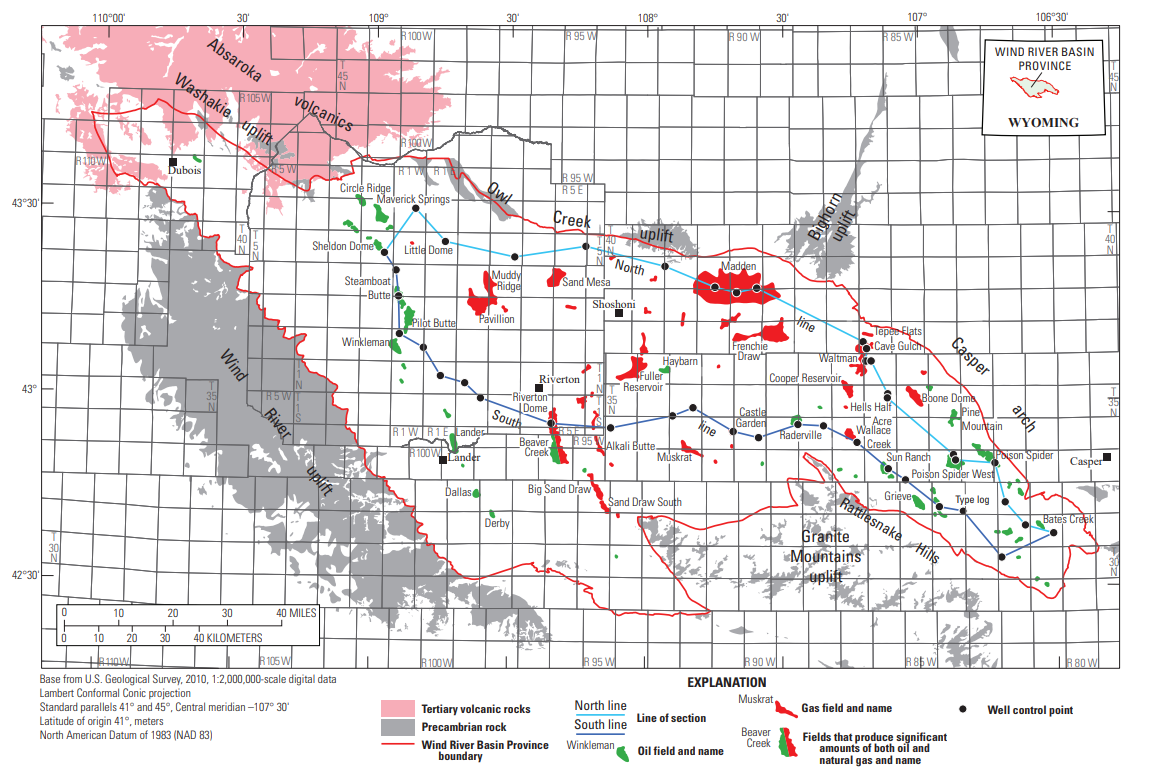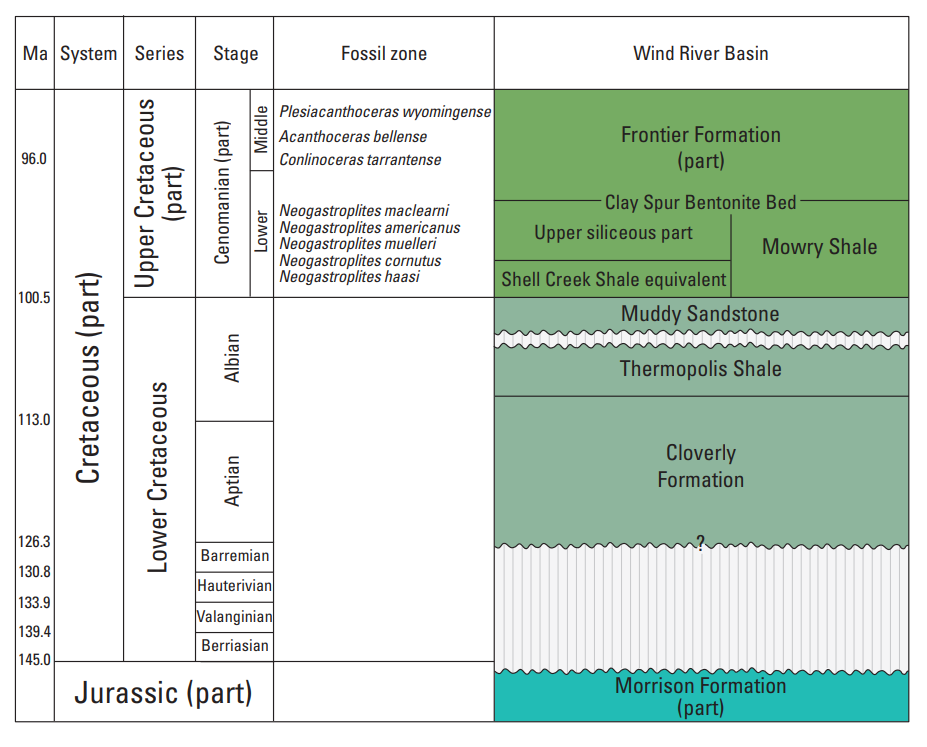Shoshone Basin on:
[Wikipedia]
[Google]
[Amazon]

 The Wind River Basin is a semi-arid
The Wind River Basin is a semi-arid

 The Wind River Basin is a semi-arid
The Wind River Basin is a semi-arid intermontane
Intermontane is a physiographic adjective formed from the prefix " inter-" (''signifying among, between, amid, during, within, mutual, reciprocal'') and the adjective "montane" (inhabiting, or growing in mountainous regions, especially cool, mo ...
foreland basin
A foreland basin is a structural basin that develops adjacent and parallel to a mountain belt. Foreland basins form because the immense mass created by crustal thickening associated with the evolution of a mountain belt causes the lithospher ...
in central Wyoming
Wyoming ( ) is a landlocked U.S. state, state in the Mountain states, Mountain West subregion of the Western United States, Western United States. It borders Montana to the north and northwest, South Dakota and Nebraska to the east, Idaho t ...
, United States. It is bounded by Laramide uplifts on all sides. On the west is the Wind River Range
The Wind River Range (or "Winds" for short) is a mountain range of the Rocky Mountains in western Wyoming in the United States. The range runs roughly NW–SE for approximately . The Continental Divide follows the crest of the range and incl ...
and on the North are the Absaroka Range and the Owl Creek Mountains
The Owl Creek Mountains are a subrange of the Rocky Mountains in central Wyoming in the United States, running east to west to form a bridge between the Absaroka Range to the northwest and the Bridger Mountains to the east. The range forms the bo ...
. The Casper Arch separates the Wind River from the Powder River Basin
The Powder River Basin is a geologic structural basin in southeast Montana and northeast Wyoming, about east to west and north to south, known for its extensive coal reserves. The former hunting grounds of the Oglala Lakota, the area is very ...
to the east and the Sweetwater Uplift ( Granite Range) lies to the south. The basin contains a sequence of of predominantly marine sediments deposited during the Paleozoic
The Paleozoic ( , , ; or Palaeozoic) Era is the first of three Era (geology), geological eras of the Phanerozoic Eon. Beginning 538.8 million years ago (Ma), it succeeds the Neoproterozoic (the last era of the Proterozoic Eon) and ends 251.9 Ma a ...
and Mesozoic
The Mesozoic Era is the Era (geology), era of Earth's Geologic time scale, geological history, lasting from about , comprising the Triassic, Jurassic and Cretaceous Period (geology), Periods. It is characterized by the dominance of archosaurian r ...
Eras. During the Laramide over of Eocene
The Eocene ( ) is a geological epoch (geology), epoch that lasted from about 56 to 33.9 million years ago (Ma). It is the second epoch of the Paleogene Period (geology), Period in the modern Cenozoic Era (geology), Era. The name ''Eocene'' comes ...
lacustrine and fluvial sediments were deposited within the basin. Following the Eocene an additional of sediments were deposited before, and as the basin was uplifted in the late Tertiary
Tertiary (from Latin, meaning 'third' or 'of the third degree/order..') may refer to:
* Tertiary period, an obsolete geologic period spanning from 66 to 2.6 million years ago
* Tertiary (chemistry), a term describing bonding patterns in organic ch ...
.
The geological formation
A geological formation, or simply formation, is a body of rock having a consistent set of physical characteristics (lithology) that distinguishes it from adjacent bodies of rock, and which occupies a particular position in the layers of rock expo ...
s within the basin are significant producers of petroleum
Petroleum, also known as crude oil or simply oil, is a naturally occurring, yellowish-black liquid chemical mixture found in geological formations, consisting mainly of hydrocarbons. The term ''petroleum'' refers both to naturally occurring un ...
and natural gas
Natural gas (also fossil gas, methane gas, and gas) is a naturally occurring compound of gaseous hydrocarbons, primarily methane (95%), small amounts of higher alkanes, and traces of carbon dioxide and nitrogen, hydrogen sulfide and helium ...
. The basin contains over 60 oil and gas fields mostly as structural traps within seventeen different formations. The primary reservoirs include the Pennsylvanian Tensleep Sandstone, the Permian
The Permian ( ) is a geologic period and System (stratigraphy), stratigraphic system which spans 47 million years, from the end of the Carboniferous Period million years ago (Mya), to the beginning of the Triassic Period 251.902 Mya. It is the s ...
Phosphoria Formation and the Cretaceous
The Cretaceous ( ) is a geological period that lasted from about 143.1 to 66 mya (unit), million years ago (Mya). It is the third and final period of the Mesozoic Era (geology), Era, as well as the longest. At around 77.1 million years, it is the ...
Muddy Creek and Frontier sandstones.
Pollution from Fracking
In 2015 a peer-reviewed study came out revealing water wells inPavilion
In architecture, ''pavilion'' has several meanings;
* It may be a subsidiary building that is either positioned separately or as an attachment to a main building. Often it is associated with pleasure. In palaces and traditional mansions of Asia ...
are contaminated with fracking wastes.
This contamination, linked to chemicals used in hydraulic fracturing, extends to the entire Wind River Basin's groundwater. The study is a challenge to the EPA's previous position by suggesting that fracking, a widespread method for oil and gas extraction in the U.S., might be causing widespread contamination. Contrary to industry assurances about the safety of water wells in the area, the study's conclusions are drawn from an exhaustive analysis of data, including the levels of methanol and diesel compounds. These indicators point to possible contamination from fracking fluid and chemical storage in unlined pits. Furthermore, the research highlights a concerning upward flow of groundwater in the basin, a factor that raises alarms about the possibility of long-term contamination migrating closer to the surface. This new evidence contradicts earlier conclusions from the EPA and state regulators, who had previously downplayed the impact of fracking on water resources.
History
The first oil strike within the basin was from the Dallas dome in the western part of the basin. This discovery in 1884 was the first commercial production in Wyoming.Population
The Wind River Basin is home to the cities of Riverton and Lander as well as the towns of Shoshoni,Pavilion
In architecture, ''pavilion'' has several meanings;
* It may be a subsidiary building that is either positioned separately or as an attachment to a main building. Often it is associated with pleasure. In palaces and traditional mansions of Asia ...
, and Hudson
Hudson may refer to:
People
* Hudson (given name)
* Hudson (surname)
* Hudson (footballer, born 1986), Hudson Fernando Tobias de Carvalho, Brazilian football right-back
* Hudson (footballer, born 1988), Hudson Rodrigues dos Santos, Brazilian f ...
, the Census Designated Place
A census-designated place (CDP) is a Place (United States Census Bureau), concentration of population defined by the United States Census Bureau for statistical purposes only.
CDPs have been used in each decennial census since 1980 as the counte ...
of Crowheart, and the unincorporated communities of Kinnear, Morton, and Midvale Much of the Wind River Basin is within the boundaries of the Wind River Indian Reservation
The Wind River Indian Reservation, in the west-central portion of the U.S. state of Wyoming, is shared by two Native Americans in the United States, Native American tribes, the Eastern Shoshone (, ''meaning: "buffalo eaters"'') and the Norther ...
. The basin is drained primarily by the Wind River and its tributaries.
See also
*Bighorn Basin
The Bighorn Basin is a plateau region and intermontane basin, approximately 100 miles (160 km) wide, in north-central Wyoming in the United States. It is bounded by the Absaroka Range on the west, the Pryor Mountains on the north, the Bigho ...
* Wyoming Basin shrub steppe
References
Geology of Wyoming Landforms of Wyoming Economic geology Sedimentary basins of North America Wind River Indian Reservation {{US-geology-stub